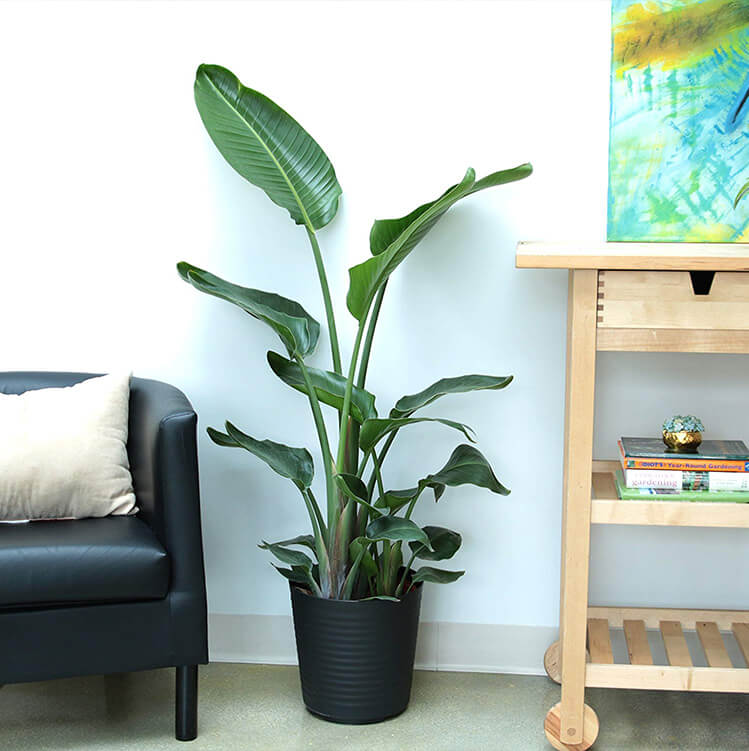For anyone that has been paying attention to trends in interior decor, the explosion of indoor plant styling is practically impossible to ignore. Flip through any current home magazine or scan social media feeds and you’ll see plenty of indoor plants, artfully displayed.
As every interior has its own style, we have curated the top indoor plant trends stylists are buying that will suit your individual “look and feel”.
Minimalist
Rubber Plant (Ficus Elastica): If you like to keep things simple and minimalist, then look no further than the rubber plant (fiscus elastica). Popular around 30 years ago, this ornamental plant has made a comeback over the past five years or so. It can grow up to 30 metres outside but when grown indoors, they are much lower in height and manageable. The foliage is fantastic and the plant is similar to a tree, making it a fashionable and prominent statement houseplant. They’re easy to care for and very forgiving house guests.
Snake Plant (Sansevieria): For a minimalist style with a retro twist, try the snake
plant. Snake plants are very low maintenance and will thrive in just about any amount of lighting, even in dark corners. They prefer dry soil and will do best when only watered once every two to three weeks. The trick to turning this retro plant into a minimalist look is how you style it with a pot.
Modern
Bird of Paradise (Strelitzia Nicolai) : Add drama and structure your home with the bird of paradise. These plants need little care, are able to tolerate strong sun and little water. As the bird of paradise is a very architectural plant, position it with plenty of space around them and against a plain wall, so their statuesque shape and vibrant flowers can be fully enjoyed. As they are slow growing they can be grown in pots for many years.
Large Leaf Jade (Crassula Ovata): The succulent trend is showing no sign of slowing down, as their unique appearance, hardiness and versatility has made them incredibly popular amongst green and black thumbs. Considered a symbol of good luck, large leaf jades are an easy to care for succulent, and can be grown indoors and outdoors, and even as bonsai plants. Fast growing, inexpensive and incredibly resilient, you cannot go wrong with this plant. An interesting trend being seen with jade plants is growing them in water.
Boho
String cactus (Rhipsalis) in a hanging basket: Recent years have seen an exciting boho trend returning to our homes – the use of hanging succulents draping from pots, giving a luscious jungle look. Even macramé pot hangers are cool again! Hanging baskets went out of vogue due the difficulty in caring for them. This is because plants that are typically used in hanging baskets, such as ferns, require regular watering. However, trailing succulents are the perfect solution as they don’t need a lot of water but still provide loads of greenery.
Cacti: Cacti are essential when going for a boho look, whether in entryways of traditional homes or offices in boho pads, the handsome cactus can be used in practically any space. They are especially effective when their weird and wonderful leaves are “curated” in eclectic collections of pots.
Scandi
Devil’s Ivy “pothos plant”: Described by some designers as the new “it” plant, with a little imagination and the bare-minimum of plant care, Devil’s Ivy can be statement-making. Scandi style is all about stripping things back to the basics, which makes smaller indoor plants such as Devil’s Ivy popular, rather than larger plants such as the fiddle leaf fig or rubber plant. It’s a great choice to hang or put on a shelf, as it grows fast and cascades beautifully, with dazzlingly long vines of verdant green.
Cast Iron Plant (Aspidistra Elatior): Aptly named ‘cast-iron plant’ for its ability to withstand even the most adverse conditions, this plant gained popularity in homes in Europe and America during the Victorian era, and it had a recent resurgence of popularity. It is especially favoured stylists as it is a slow growing plant that can survive even the most extreme conditions where other plants would shrivel and die.
Retro
Fruit salad plant (Monstera deliciosa) / Swiss cheese plant (Monstera adasonii): Popular in the ‘70s and ‘80s, but now cropping up everywhere, these two plants have becom the symbol of the millennial houseplant phenomenon. Planted in a pot and brought indoors, they are sure to create a retro, luxe mood. Their large, split leaves have become iconic and make a statement in any home.
Coastal
Golden Cane Palm: There’s no better way to channel beach vibes into your home than a towering golden cane palm. Its big, bold leaves and dark greenery create the feeling of a coastal interior, especially if you have room for larger palms that instantly remind you of being near the ocean. The golden cane palm is a popular choice as it is a fast grower and will be happy in most indoor conditions – even in low light. Plus, it’s a proven air purifier.
Lady Palm: Highly decorative, the lady palm, or Rhapis palm, gives an exotic, tropical feel to any living room or interior. It is a slow growing palm with large, fan-shaped, glossy leaves atop multiple fibrous stems. It’s a popular choice for an indoor coastal look as it will tolerate low light and low humidity.
Traditional
Peace Lily (Spathiphyllum): One of the most classic houseplants, the peace lily, has been a popular choice as an indoor plant as it is not only beautiful but is also one of the easiest houseplants to grow. The peace lily has been proven to be among the best houseplants to help improve indoor air quality. They will happily grow in low light conditions but will rarely bloom. Therefore, if you want flowers, place it where it will receive bright, indirect light.
Need advice about choosing from our list of indoor plant trends?
If you’re wanting to add some greenery to your interiors and want some advice about which plants would suit your decor, talk to our team!



